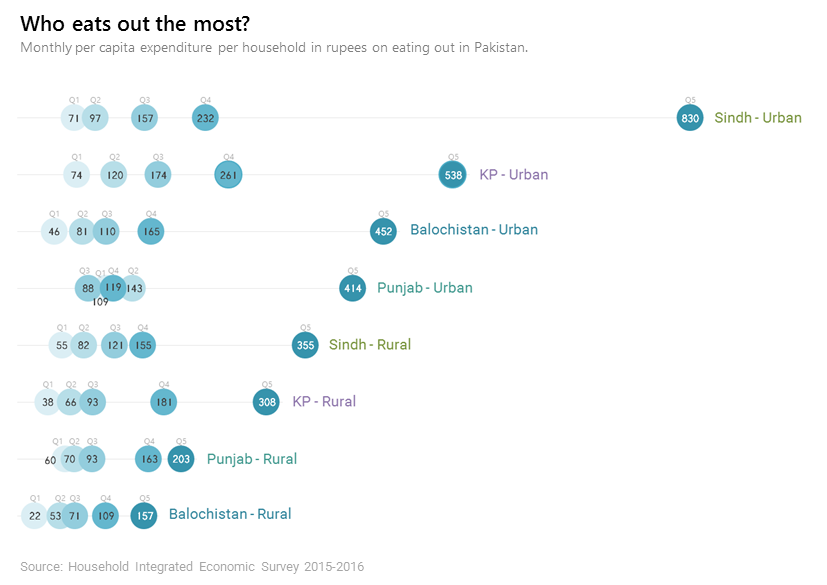You know Pakistanis have their priorities right when they spend more on eating out in a month than they do on education.
The average household in urban Pakistan allocates around 7% of its total monthly expenditure to ‘Restaurants and Hotels’, a major component of which is eating out. In contrast, 5% of their monthly expenditure is on Education. This is based on consumption expenditure data from the Household Integrated Economic Survey 2015-2016.
The same is also true for rural Pakistan. Makes sense, after all, school fees and education expenditure per household tend to be much lower in rural regions. But their relative expenditure on restaurants and hotels is pretty much on par with the urban centres (reflected in the steeper slopes in the charts below for rural compared to urban areas).
This pattern holds across virtually all regions and every quintile* within them. Priorities, basically.
Urban Punjab is an exception, achieving a neat balance between both essential modern day needs by allocating 7% of total expenditure to each.
What does this translate to in terms of actual rupees spent?
As one would expect, per capita expenditure per household on eating out (readymade food eaten at home and food eaten in restaurants and cafes from the ‘Restaurants and Hotels’ category) is higher for each successive quintile (urban Punjab again an exception lacking such a clear cut relationship).
But what is most interesting is urban Sindh, which is heavily influenced by Karachi. With an average of Rs 830 per person on eating out every month in the top quintile, these are easily the biggest foodies.
Also interestingly urban Punjab ranks last among all the urban regions. Who would have thought?
Caveats:
- The Restaurants and Hotel category also includes expenditure on food and drink at weddings, religious occasions, qurbani and any kind of party. They probably couldn’t think of any other convenient category to stick them under I suppose, but it does skew the above figures.
- The top quintile in rural Balochistan seems to spend a lot on Hotels and Restaurants, all down to their food expenditure at weddings and religious occasions. Either some mega-rich households go all out at these events or there were some data collection issues here.
- The distribution of expenditures within cohorts can be heavily skewed with resulting averages being significantly influenced by large expenditures by a wealthier minority in the subset. This is particularly true for the fifth quintile which has an average income of Rs 60,451 for all of Pakistan. There are considerable differences in lifestyle and expenditure patterns across households at the lower end of this quintile and those at substantially higher income levels within the same quintile, which an average figure does not reveal.
- Population differences across provinces also limit generalizations about eating out habits. Karachi and Lahore, the more affluent cities, are the ones where eating out expenditure is likely to be highest. Karachi accounts for 60% of Urban Sindh’s population which is reflected in Urban Sindh leading all regional comparisons. However, Lahore accounts for only 28% of Punjab – Urban’s population, so there’s a larger averaging out effect of other substantially different urban areas in this grouping and hence the lower figures.
*Quintile represents each successive 20% of the population by consumption expenditure. Q1=lowest quintile, Q5=highest quintile



